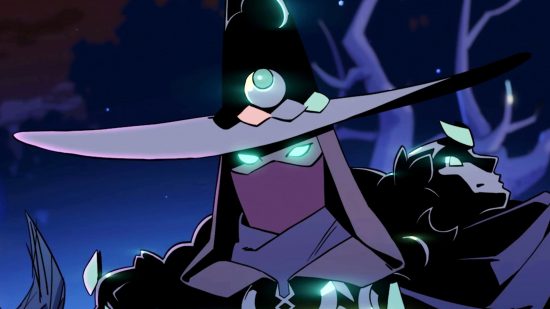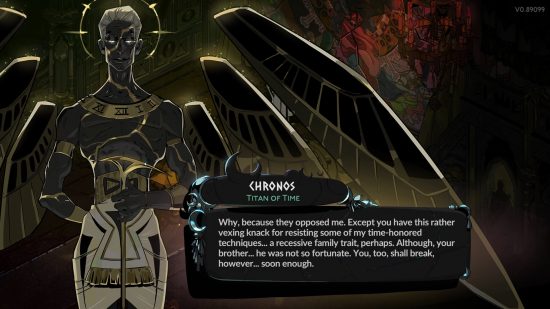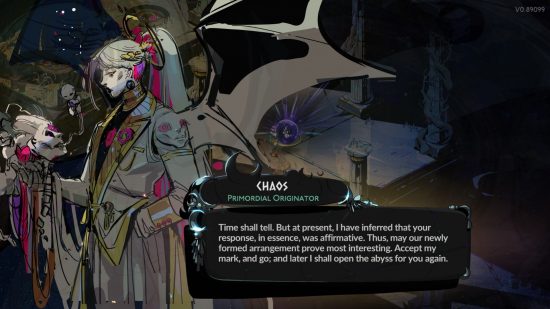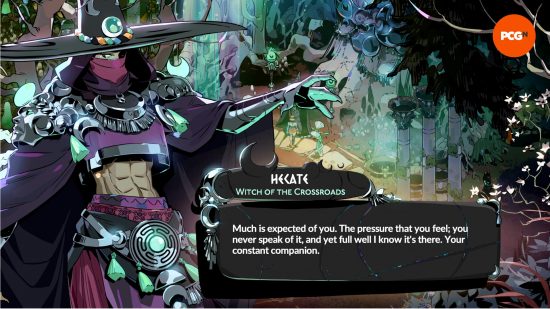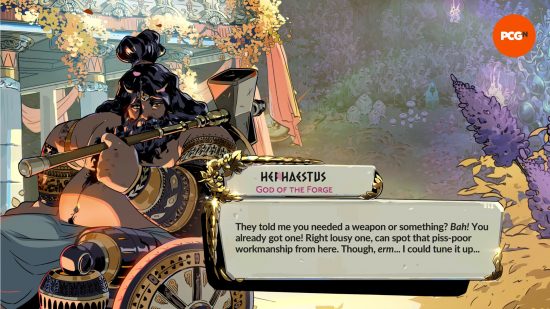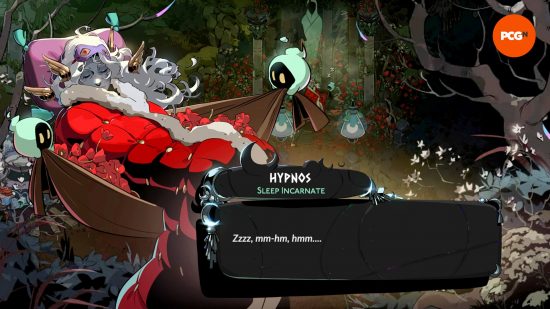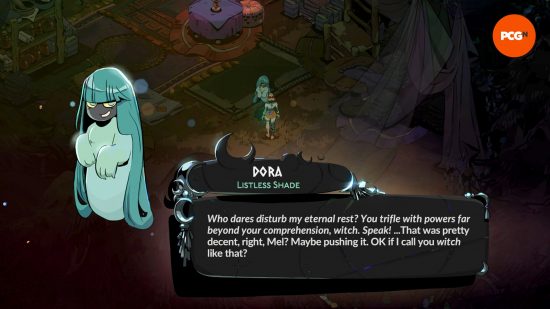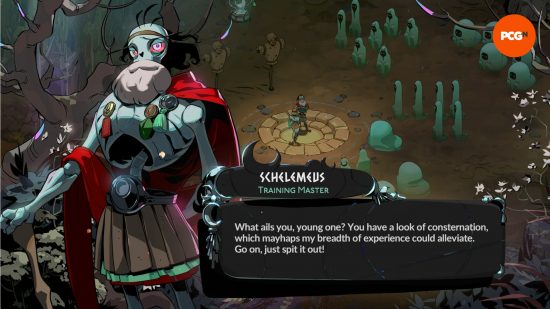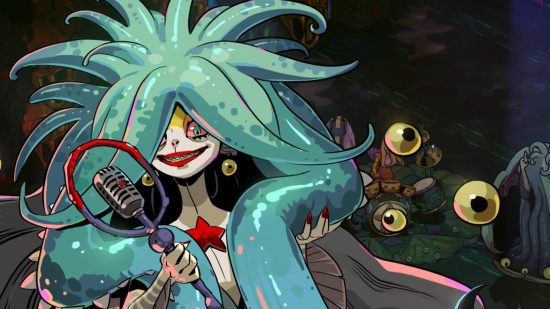Who are the Hades 2 Gods and characters? As you explore the underworld, a compelling cast of colorful characters is waiting to help you on your journey. Some NPCs are there to test you, aid you in mastering your skills, and sell you useful items. Gods, on the other hand, appear at random to give you special items to aid you in combat.
Whenever you start a new crawl through the dungeons of Hades 2, or pass through a gate into the next, you can interact with a randomly allocated Sigil that is usually associated with one of the Greek gods. These Hades 2 Boons grant you a choice of buff to your attack or defense, themed around the God offering their help. But which Hades 2 Gods do you have the chance to meet in the roguelike game, and just how does their Greek mythology relate to the Hades 2 story? Read on to find out.

All Hades 2 Gods
Greek myth, including the stories and characters, has always been incredibly fluid after being passed down orally for thousands of years, and Supergiant Games made it their mission in the first game to take the myths and expand the characters in modern and believable ways, so expect some twists on what we know.
The Greek gods who appear in Hades 2 are:
- Melinoë
- Hades
- Aphrodite
- Apollo
- Artemis
- Charon
- Chaos
- Chronos
- Circe
- Demeter
- Eris
- Hecate
- Hephaestus
- Hera
- Heracles
- Hermes
- Hestia
- Hypnos
- Lord Moros
- Medea
- Narcissus
- Nemesis
- Odysseus
- Poseidon
- Zeus
Melinoë
Melinoë is Zagreus’ brother and Hades’ daughter in Hades 2, and the game’s protagonist, and while her history in the ancient world is a little murky, one orphic Hymn from around 2,000 years ago does tell us a little bit about her. With limbs black on one side and white on the other, she was in charge of appeasements offered to ghosts of the dead.
The goddess’ dual black and white limbs are seemingly intended to represent her split between the underworld and the heavenly world above. All we really know about Melinoë then is that she’s described as the daughter of Persephone and Hades (sometimes called a variation of Zeus), and she was heavily involved with the ghosts of the dead. It’s also believed by some that Melinoë was the orphic title for Hecate, though she appears as a separate Hades 2 God.
Hades
While Hades is the name of the underworld itself, we also know Hades to be the God of the Underworld, and supposedly Melinoë’s father. While all relationships in Greek mythology are pretty intricate, Hades’ are perhaps the most complex, with relations to most of the other Hades 2 Gods and characters.
Spoiler alert: if you didn’t already know, Hades isn’t actually the father of Melinoë in Greek mythology. Zeus was instead known to take the form of Hades in many myths, including in order to trick Melinoë’s mother, Persephone. Melinoë doesn’t appear to be aware of this though, so whether this will come out in Hades 2, or just what role Hades himself may play, we are yet to find out.
Chronos
Chronos is the villain of the Hades 2 gods, imprisoned in chains at the end of the trailer, and acting as the driving force of the narrative, referred to as “time itself.”
The god of time and King of Titans, Chronos devoured his own children, except Zeus, in fear of a prophecy saying he would be overthrown by his own son. Zeus then later saved his siblings and imprisoned Chronos, despite releasing him later and making him ruler of the Elysian Islands (which is an inspiration for the third floor of the original Hades, actually), where heroes were sent by the gods after death.
A father then to both Zeus and Hades, as well as Poseidon, Hera, and Hestia, the god of time is probably just a little pissed that he was imprisoned. While the circumstances may be different for the Hades 2 gods, I’d hazard a guess that Hades’ own imprisonment is a form of revenge, with Chronos’ relationship with time potentially playing into the repeated roguelike element of Hades 2 runs – time travel, perhaps? This remains to be seen, as Chronos doesn’t appear in the technical test.
Aphrodite
The mythology of Aphrodite is perhaps one of the most well-known. As the Goddess of love and fertility, Aphrodite is known as having been borne from a suggestive substance that came from the severed genitals of Uranus. It was suggested that the genitals were thrown into the sea by Cronus, the son of Uranus, and thus Aphrodite also became known as a goddess of the sea. The more famous representation as the Goddess of Love is used in Hades 2, though, as Aphrodite appears as a beautiful, nude woman, with pink-toned skin, and luscious pink hair covering her body.
Aphrodite was also known to have been betrothed to Hephaestus, who also appears in Hades 2. Given the mismatched partnership, Aphrodite supposedly had an affair with Ares, the God of War. Given Aphrodite’s relationship to Cronus and Hephaestus, perhaps more of her story with the two other Hades 2 characters will play out. While Ares was in Hades, we don’t yet know if the God of War is set to make an appearance in Hades 2.
Apollo
In Hades 2, Apollo is the God of Light, but, from mythology, is actually the god of a lot of things (as many gods were).
A god that’s appeared many times in ancient Greek culture, often depicted with a lyre, quiver and bow, and a raven. Supergiant is seemingly combining the bow and lyre for their interpretation, as Apollo is pictured in-game holding a bow with many strings, mimicking the look of a lyre.
Artemis
While Artemis is also known as the Goddess of chastity and childbirth in some Greek mythology, Supermassive has more aptly chosen to use her more widely known status as Goddess of the Hunt for Hades 2.
Greek mythology also places Artemis as the twin sister of Apollo, but mostly in the lore of her being the childbirth goddess, given that she is birthed first and proceeds to help her mother, Leto, give birth to Apollo. Whether or not this relationship will play out in Hades 2 remains to be seen, but we wouldn’t expect so, given that the focus is on Artemis as a huntress.
No other confirmed Hades 2 characters are particularly close to Artemis, but her father is Zeus, so she is linked to most other characters through the paternal line. Interestingly, as you can see in the screenshot above, Artemis immediately refers to Melinoë as “sister”, though whether she means this literally of course is a mystery. As the daughter of Zeus, she is, of course, but as far as we are aware, Melinoë doesn’t believe Zeus to be her father.
Charon
Charon is the Stygian Boatman, in other words, the ferryman who sails the dead into the underworld. According to Greek myth, the crossing required payment, and those who could not pay were not given passage, but instead left to wander the shores for eternity. As such, the Greeks often placed a coin in the mouth of their deceased to ensure they had payment upon arrival.
This theme of payment is very relevant to Charon’s character in Hades 2, as he is a merchant of goods. In Hades 2, you can purchase items, such as Boons, from Charon in exchange for gold, which differs from the payments of Obols from the first game.
Chaos
Chaos, a confirmed non-binary character in the Hades series, has shifted their appearance from the original game to Hades 2. They now present with a pink and purple undercut, long gray hair, and flowing robes. Despite the appearance shift, they still exist to serve the same purpose – to mix up Melinoe’s journey, offering powerful Boons that cast all normality aside.
Chaos stems from “untold aeons ago” when they sprang forth Night and Darkness, and it is said that all living things descend from them.
Demeter
Demeter is known as the Goddess of the Harvest, or Goddess of Seasons, and is referred to as the latter in Hades 2. That said, the theme entwined into Hades 2 seems to be more about Winter and its effect on crops, given the names and effects of Demeter’s Boons.
As one of the siblings of Hades and Zeus, this is where things get a bit confusing, because Demeter is also Melinoë’s Grandmother, as the mother of Persephone. Her connection to the paternal side of Melinoë’s heritage is the complicated part, due to the interfamilial relations Zeus was known for. This is important because, as you can read below, Hades isn’t the father of Melinoë, as we’re led to believe in Hades 2, and as Melinoë herself believes.
Like all of Chronos’ children, Demeter is sure to be particularly interested in his demise.
Eris
Eris is the personification of strife. She resists any form of order, whether implied through nature or enforced by the gods and goddesses. Despite that, Melinoe finds herself drawn to Eris repeatedly throughout Hades 2.
Eris is also the final boss of the ascent to Olympus and puts up quite the fight. She formerly wielded Exagryph, the Adamant Rail, which is a weapon found in the original Hades game and resembles a gun with an eagle shape upon it. The Adamant Rail is not currently available in Hades 2, but with the game remaining in early access for some time, it could be added down the line.
Hecate
If we take Hecate as a separate entity from Melinoë, as Supergiant has in Hades 2 as the woman clad in all-black robes, she’s the goddess of magic, spells, the moon, and the night. In Hades 2, Hecate will assist Melinoë in her quest against Chronos, training her in the ways of witchcraft and combat.
Shrines to Hecate would be placed at entrances to homes to ward off witchcraft and evil, according to many contemporary plays from the likes of Euripides and Aristophanes. We may also see connections to other gods from the first Hades, as Hecate helped Demeter search for her daughter Persephone in myth after she was abducted by Hades.
The Homeric Hymn to Demeter also states that Hecate then acted as Persephone’s companion when she traveled to the underworld to spend a third of every year with Hades (Greek myth is a tad confusing, don’t worry about it), with Hecate’s guidance often represented by the iconography of a torch.
Hera
Hera is the Queen of Olympus, Zeus’s wife, and is tasked with ensuring some order remains there. You can encounter her on your journey down to Tartarus, or up to the surface, and she will grant you powerful Boons.
As the goddess of marriage and the daughter of the titans Hyperion and Theia, her sisters are Hestia, Demeter, Helios, Selene, and Eos. Whether they share the same parentage is a different matter. Are you learning not to question Greek mythology and familial ties by this point in the guide? You probably should.
Heracles
Heracles appears as an NPC at various encounters, similar to Artemis and Nemesis. He will set challenges, such as beating more enemies than he does within a set window of time, to earn greater rewards. You can gift him Nectar to receive his keepsake, but can only reach a maximum of three hearts in his relationship with you, with the third coming only when you have progressed the game’s story.
Heracles is a “monster of a man” and appears wearing a bear skin over his impressive mane and beard. He disagrees with witchcraft and poses a danger to anyone he encounters, as well as himself. You’ll only come face-to-face with him on your journeys to the surface.
Hephaestus
The God of the Forge, Hephaestus, is known for crafting and metalwork, so is appropriately associated with such in Hades 2, offering boosts to Melinoë’s defense and weaponry.
As the ill-fated husband of Aphrodite, there could be some interaction between the two characters in Hades 2, but we wouldn’t expect it to be friendly, given that Aphrodite chose to philander with Ares. Born lame, according to mythology, we can see Hephaestus is depicted in a wheeled chair, but he also seems to have a metallic prosthetic leg, presumably cast by himself given his talents.
Hestia
The Goddess of the Flame, Hestia naturally offers fire-themed Boons to Melinoë. She seems to have a great personality, referring to Melinoë as “hot stuff” as well as making other fire-related puns in her dialogue. The Goddess also refers to herself as “elderly”, suggesting she is one of the elder Hades 2 gods. This tracks with her mythology as she again is one of the siblings of Hades, making her an aunt to Melinoë.
The name Hestia refers directly to the hearth, and the most common interpretation of the goddess is her affinity to a hearth in the home, thus warmth and family. This perhaps is another reason she speaks so casually and jovially to Melinoë, a member of her own family.
Hestia is another of Chronos’ five children, alongside Zeus, Hades, Hera, and Poseidon, so is another of the Hades 2 Gods we are sure will be particularly helpful in bringing their father, the main Hades 2 villain, to justice.
Hypnos
Now, Hypnos is a god we can relate to. Also known as the Sleep Incarnate, Hypnos has so far been found, unsurprisingly, fast asleep in Hades 2. This follows the ending of the first game (another spoiler alert!) during which Hypnos falls into a deep sleep. His role in Hades was to greet Zagreus after his death, a role which seems to have been filled by Lord Moros in Hades 2. According to Greek mythology, Hypnos is the twin brother of the God of Death, Thanatos, who you’d also think would be connected to death in Hades 2. Thanatos did appear in Hades, but so far has not been confirmed for Hades 2.
In the Iliad, Hypnos has a bad history with Zeus, having put him to sleep multiple times at the behest of Zeus’ wife Hera, to be used as a victim of trickery. Naturally, Zeus was furious when he awoke, so presumably isn’t the biggest fan of Hypnos. Regardless, we have no idea how Hypnos’ story will play out in Hades 2 as we so far can’t get him to wake, but we’re sure there must be a reason for his presence in the Crossroads.
Lord Moros
Greek god Moros, or “Doom Incarnate”, appears to Melinoë after several deaths, which relates to his mythology of doom, demise, and his immortality. Moros is also the son of Nyx, Zagreus’ sort-of adopted mother in the original Hades, so it isn’t too surprising that Moros looks to help Melinoë, as they’ll likely have a pre-existing relationship. Ares helped you inflict the Doom effect in the first game, but it’s unclear if Moros will be tied to that as of yet. So far, we know that Moros has a connection to incantations, and can be summoned using Doomed Beckoning at the cauldron.
Nemesis
Nemesis, who I’m sure is already giving Lady Dimitrescu fan artists a run for their money, is described as Retribution Incarnate in Hades 2. The goddess of revenge and retribution, Nemesis is basically a good old-fashioned comeuppance.
While sometimes contested, it is widely believed she is also a child of Nyx, potentially further tying Nemesis together with the first Hades nicely. One of the most famous myths Nemesis is involved with is that of Narcissus, a handsome hunter who was terrible to any of his admirers, so Nemesis lured him to a pool where he fell in love with his own reflection, eventually dying as he couldn’t bear to look away (mood).
With multiple ties to Nyx from gods and goddesses in Hades 2, the old consort of gods from the first game will likely play some sort of role in the sequel, even if they don’t appear directly.
Poseidon
Poseidon, God of the Sea, is the final sibling of Zeus we know is in Hades 2, alongside Hades, Demeter, and Hestia.
It is believed that Poseidon became the God of the Sea when he and his siblings overthrew their father, Chronus himself, and the sea, sky, and underworld were split between Chronus’ three sons, Poseidon, Zeus, and Hades. Naturally, given their tumultuous past, Poseidon, like his siblings, is keen to help defeat Chronos once more.
In his Hades 2 introduction, Poseidon refers to the disappearance of Zagreus, Persephone, and Hades, all currently missing at the start of the second game. He is Melinoe’s uncle, occasionally called the “Earthshaker” for his boisterous nature.
Selene
The Goddess of the Moon, Selene is a beautiful woman who appears to Melinoë atop a stunning white, winged horse with a silver mane. This is true to her Greek mythology, in which Selene traveled either side-saddle on her horse, as she does in Hades 2, or a chariot, pulled by two horses, itself pulling the moon behind it.
So far, Selene is surprisingly lonesome in Hades 2, although the in-game guide refers to her as being “fostered by Nyx herself.” She is related to Helios and Eos, neither of whom appear in Hades 2. That said, Selene does have a relationship with some of the other Gods, not least Zeus, who granted her beloved, the human man Endymion, the gift of eternal youth and life.
Zeus
Zeus is arguably the string that ties all of the Hades 2 Gods together. Father to many, brother to some, King of all, Zeus, as we’ve mentioned above, is technically the true father to Melinoë, according to Greek myth. Whether this will be revealed to Melinoë, who believes her father is Hades, remains to be seen.
All of this is true to the myth, as Zeus disguised himself as Hades to trick Melinoë’s mother, Persephone. Via many mothers, though, Zeus is also father to Hephaestus, Artemis, Apollo, Persephone herself – don’t ask, it’s Greek myth – and many other gods and goddesses who don’t appear in Hades or Hades 2. Zeus is stated in the game to have taken Olympus after “deposing” his own father, Chronos.
Other Hades 2 characters
The other Hades 2 NPCs who make an appearance in various areas are:
- Arachne
- Cerberus
- Dora
- Odysseus
- Polyphemus
- Schelemeus
- Scylla
- Icarus
- Frinos
- Hecuba and Gale
Arachne
Arachne is possibly one of the most adorable Hades 2 characters, pictured as a small spider with a beautiful woman’s head, with blonde curls atop her head. This form represents Arachne’s fate in Greek mythology, as the mortal witch was turned into a spider after a run in with Athena.
Gifted in weaving, Arachne was a mortal many believed to have a magical affinity as an explanation for her talent. However, she was not, and the knowledge of just how wonderful her weaving ability was went to her head. According to her lore, Arachne got so cocky that she claimed her skill to be greater than the gods’, her tutor Athena in particular, and challenged Athena to an artistic duel. This wasn’t the extent of her hubris, though, as her weaving depicted the Gods’ infidelities and wrongdoings, resulting in Athena turning her into a spider.
Cerberus
Cerberus appears in an altered state when you first encounter him, as a boss fight guarding the descent to Tartarus. Melinoe suspects this is Chronos’s doing, and we’re inclined to agree. He’ll appear as “Infernal Cerberus” but upon defeating him, you’ll see him take his original form.
We’ve not progressed the story to its completion yet, and we’re unsure if it’ll happen in early access, but if Hades 2 follows its predecessor, we may well see Cerberus take up residence in the Crossroads. We can hope and dream, right? We’ve missed the big, drooling, three-headed pupper.
Dora
Dora, or the Listless Shade, appears in Hades 2 in two forms, one as an adorable mint-green ghost-girl with long turquoise hair, while the other is a seemingly evil shade, simply glowing facial features under a cloak.
It is widely believed that Dora is based on Pandora, and while there is no connection to her ghostly form, Pandora was responsible for releasing all of the evils of humanity onto the world upon opening Pandora’s Box. Again, Dora seems far from evil in Hades 2, but clearly has the affinity to spook people in her darker form. She doesn’t act this way around Melinoë, and the pair seem to be good friends, with Dora seemingly appearing to haunt Melinoë in her other form as a method of practice only. Her interactions with Melinoë, though, are often cheeky and a little chaotic, so it may be that Supermassive decided to interpret her evil this way.
Odysseus
Odysseus is a Greek King, who appears alongside many of the kings, queens, gods, and goddesses of Hades 2 in the Iliad, but is primarily known as the eponymous hero of The Odyssey. As a human, his interaction with the Gods is fairly indirect, but he is depicted as having had a good relationship with Zeus and Athena who save his life by discouraging vengeful enemies from killing him. By contrast, in a conversation with Melinoë in Hades 2, Odysseus reveals that Poseidon is not such a fan.
Odysseus makes his series debut in Hades 2, appearing in the Crossroads as the Veteran Tactician,
Schelemeus
Schelemeus, previously known as Skelly, is once again your combat trainer in Hades 2, appearing in the Crossroads. Little is known about Schelemeus’ backstory, and we’re hoping to find out more in Hades 2, especially given Odysseus’ appearance in the sequel.
Odysseus did not appear in the first game, and there has been a long-time fan theory that Skelly was actually Odysseus. Some believe this has now been disproven, but the pair have a similar stance and armor, and both wear a gold band around their head, alongside their matching black locks. Perhaps we’ll learn more about just who Schelemeus is and their relationship to Odysseus in Hades 2.
Polyphemus
Polyphemus is a sightless Cyclops that you’ll encounter during your trips to the surface. He resides alongside a gaggle of sheep, that he’ll occasionally accidentally consume, believing in his blind rage that he’s managed to grab Melinoe.
After devouring people for a lifetime, he chose to become a shepherd as the lifestyle was too exhausting. When facing him as a boss after leaving the City of Ephyra, he’ll just be glad of the nap when you take him down.
Scylla
After being cursed by a witch, destined to have her long tendrils of aqua blue hair and a ghoulish pale complexion, Scylla sits at the bottom of the ocean waiting for players as the final boss of the Oceanus area during the descent. Unsurprisingly, she strongly dislikes witches.
She roams the sea with two other daughters of the deep, who can’t half sing. Check out our Scylla and the Sirens boss fight guide if you’re struggling to get past this tricky vocalist.
Frinos
Frinos is the only character on this list without a mythological counterpart, and the word “frinos” simply means “toad” in Greek. This adorable little companion waits for Melinoë whenever you fail in your task and return to Mel’s room, where you can interact with the little creature, sharing your thoughts with them, or simply nuzzling with them – which we recommend you try at home.
Icarus
Icarus is a free spirit in Hades 2. You’ll meet him on your journeys to the surface. Voiced by Asa Butterfield (Sex Education, Ender’s Game), this surprise appearance will grant you powerful boons with which to continue your run. We’re sure we’ll uncover more about Icarus and his appearance in the game the more we head to Olympus.
Icarus, in Greek mythology, is famously known for perishing by flying too close to the sun with waxed wings. He’s also the son of Daedalus – and those familiar with Hades will have heard of the Daedalus Hammer, a powerful Boon offered in encounters.
Hecuba and Gale
In Greek mythology, Hecuba is the Queen of Troy. In the many stories of her, Hecuba comes into contact with many of the Greek gods and kings, including Apollo, Zeus, and Odysseus, and even had a son with Apollo, Toilus, who was later killed by Achilles.
It seems as though it’s Hecuba’s interaction with Odysseus that’s referenced in Hades 2, though, as Hecuba appears as a Dobermann with whom Melinoë can interact in The Crossroads. In this story, Hecuba is taken by Odysseus as a slave, and she reacts by barking and growling at the king. As a result, the Gods turn her into a dog, allowing her to escape – apparently the form we find her in Hades 2.
Next to Hecuba, you can also find Gale, a small, brown polecat. In mythology, Gale also started out as a human and has a particularly troubled history with Hecate. Thanks to the witch’s supposedly abnormal desires, Hecate turned her into a polecat, a creature thus thought by the Greeks to have an affinity with magic.
Now you know which Hades 2 characters to look out for as you make your way through Hades itself, but we can’t help which Gods turn up, so here’s hoping RNG is on your side. Hopefully, you’re loving Hades 2 as much as we are, and you can read just how much that is in our Hades 2 preview. If you are, you might also be interested in finding out more about Hades 2 Arcana Cards, how to beat the Hades 2 bosses, and what the best Hades 2 builds are.
Additional contributions from Will Nelson.
